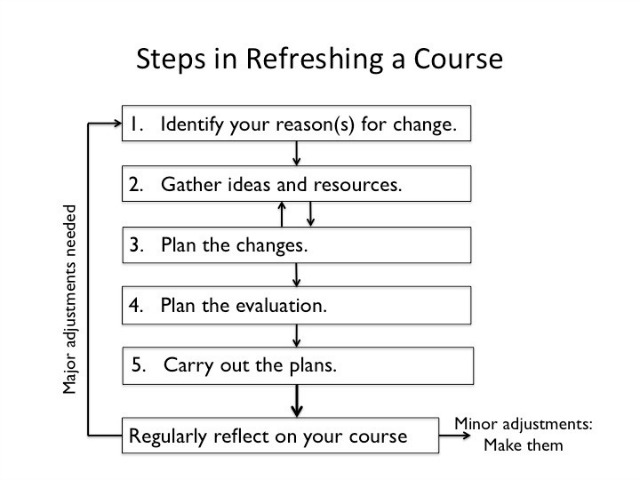 Twenty-first century skills necessitate the implementation of instruction that allows students to apply course content, take ownership of their learning, use technology meaningfully, and collaborate. Problem-Based Learning (PBL) is one pedagogical approach that might fit in your teaching toolbox.
Twenty-first century skills necessitate the implementation of instruction that allows students to apply course content, take ownership of their learning, use technology meaningfully, and collaborate. Problem-Based Learning (PBL) is one pedagogical approach that might fit in your teaching toolbox.
CURRENT ARTICLE • November 30
OTHER RECENT ARTICLES
Peer assessment in groups has been shown to effectively address a number of group process issues, but only if the peer assessment has a formative component. Many studies have shown that if peer assessment is used at the end of a group project, group members will punish their dysfunctional members—those who didn’t do work, didn’t turn work in on time, didn’t come to meetings, and didn’t do quality work—but they won’t confront those group members when they commit those dysfunctional behaviors. After-the-fact peer assessment gives the teacher input on who did and didn’t contribute in the group, but it doesn’t change what happened in that group or help students learn how to confront group member problems when they emerge.
Read More ›Goals for my First-Year Seminar students include proficiency with a host of study skills as well as course content based on what we call “learning about learning.” To support new college students in understanding what, exactly, learning is, my colleagues and I introduce a number of themes and authors to our students over the course of the first semester. Themes can include locus of control, memory learning and the brain (including information processing models), current research on learning disabilities, theories of motivation and learning, mind-set theory, emotional intelligence theories, and research on millennial students just like them. Students read materials written by authors doing work in these areas.
Read More ›Instructional strategies acquire names, labels that describe what the strategy involves—active learning, problem-based learning, cooperative learning. Sometimes the strategies gain popularity. They become widely used, and so do the terms that describe them. After a while teachers stop describing what they are doing in class. They simply refer to it by the label: “Yes, I have students work in groups. I use cooperative learning.”
Read More › Advances in neuroscience and digital imaging give us an unprecedented understanding of how individuals access, process, and respond to information. Previously we may have had an intuitive understanding that our students learned differently. Now functional MRI scans demonstrate this in living color. However, simply recognizing learner diversity is one thing; navigating this challenge in the classroom is quite another. How can we possibly hope to present content, structure learning experiences, and devise assessments that will be appropriate and effective for students with different learning strengths and challenges? Fortunately, researchers have developed a framework based in neuroscience that can help.
Advances in neuroscience and digital imaging give us an unprecedented understanding of how individuals access, process, and respond to information. Previously we may have had an intuitive understanding that our students learned differently. Now functional MRI scans demonstrate this in living color. However, simply recognizing learner diversity is one thing; navigating this challenge in the classroom is quite another. How can we possibly hope to present content, structure learning experiences, and devise assessments that will be appropriate and effective for students with different learning strengths and challenges? Fortunately, researchers have developed a framework based in neuroscience that can help.
In the 1970s, my mother, a fifth-grade teacher, would lament, “The TV remote has ruined my classroom! I can almost feel the kids trying to point a clicker at me to change the channel!” Little did she know that college students today don’t need to wish for a remote control to switch from their professor to entertainment—an endless assortment of distractions are all on their smart phones.
Read More ›The flipped classroom is a student-centered approach to teaching that involves reversing the design of the learning environment, allowing students to engage in activities, apply concepts, and focus on higher level learning outcomes during class time.
Read More ›One of the three key tenets of metacognitive engagement in the classroom is teaching students heuristic strategies specific to the subject matter (Pintrich, 2002; Bembenutty, 2009). The other two are teaching students when to use the strategies and how to self-assess the successful use of those strategies. When considering critical thinking classes, this might involve teaching specific problem solving strategies, like the difference between permutations and combinations, as well as when each should be applied. However, other types of strategies could be beneficial, such as templates for assignments, video instructions, and detailed rubrics for self-assessment.
For both new and veteran faculty, inheriting a syllabus to teach from is like being blindfolded on a long journey and being told, “Don’t worry, you’ll know it when we get there.” There’s a lot of trust required in order to follow someone else’s map. There are road hazards the mapmaker may not be aware of; there may be alternate routes that might get you there more directly; and it may even be prudent to choose another mode of transportation to get there.
Read More ›






